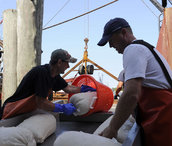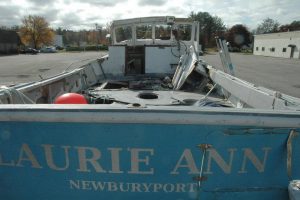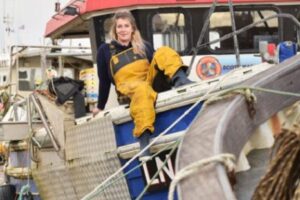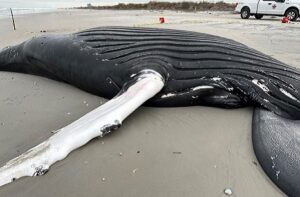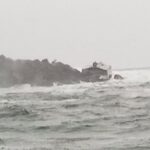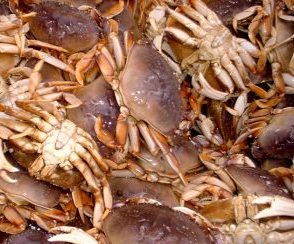Tag Archives: swordfish
N.S. swordfish harpoon fleet urged to bring tourists aboard to boost troubled sector
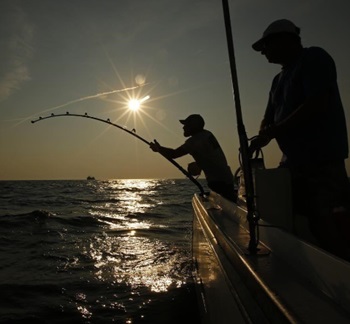 An environmental group says Nova Scotia’s commercial swordfish fleet could generate millions in added revenue by bringing tourists along for fishing trips and using different gear. The Ecology Action Centre says swordfish harpooning — lunging a long spear into the water to catch a fish — has become increasingly difficult and less economically viable because swordfish are appearing less often at the surface due to changing water conditions. In a report released Wednesday, the centre says changing ocean conditions are preventing fishers who use the traditional fishing method from fulfilling their already small swordfish quotas. The group’s solution is for the harpoon fleet to start using a single deepwater hook and line — called rod and reel gear — and to charge tourists to come aboard for a “once-in-a-lifetime experience.” more, >>CLICK TO READ<< 18:49
An environmental group says Nova Scotia’s commercial swordfish fleet could generate millions in added revenue by bringing tourists along for fishing trips and using different gear. The Ecology Action Centre says swordfish harpooning — lunging a long spear into the water to catch a fish — has become increasingly difficult and less economically viable because swordfish are appearing less often at the surface due to changing water conditions. In a report released Wednesday, the centre says changing ocean conditions are preventing fishers who use the traditional fishing method from fulfilling their already small swordfish quotas. The group’s solution is for the harpoon fleet to start using a single deepwater hook and line — called rod and reel gear — and to charge tourists to come aboard for a “once-in-a-lifetime experience.” more, >>CLICK TO READ<< 18:49
Swordfish are moving north in Canadian waters
 “It’s still unclear whether this is becoming the new normal due to climate change or if the biomass will eventually shift back again as we think it did historically,” said Fisheries and Oceans Canada biologist Kyle Gillespie. Nineteen-hundred tonnes of swordfish were landed in Canada last year. Nearly a third of the swordfish were taken off Newfoundland, where longline fishing boats from Nova Scotia trailed kilometres of baited hooks throughout much of the summer. Gillespie said this is a rapid shift from the previous decade, when the entire Canadian catch was concentrated along the Scotian Shelf and Georges Bank off southern Nova Scotia. more, >>click to read<< 08:46
“It’s still unclear whether this is becoming the new normal due to climate change or if the biomass will eventually shift back again as we think it did historically,” said Fisheries and Oceans Canada biologist Kyle Gillespie. Nineteen-hundred tonnes of swordfish were landed in Canada last year. Nearly a third of the swordfish were taken off Newfoundland, where longline fishing boats from Nova Scotia trailed kilometres of baited hooks throughout much of the summer. Gillespie said this is a rapid shift from the previous decade, when the entire Canadian catch was concentrated along the Scotian Shelf and Georges Bank off southern Nova Scotia. more, >>click to read<< 08:46
A unique partnership connects Lowcountry fishermen with people who don’t have enough to eat
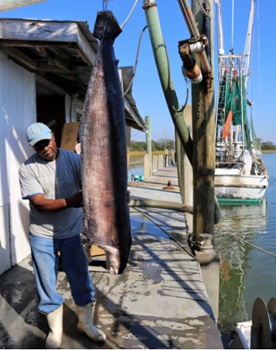 Daniel LaRoche watches as his crew, who’s just returned from nearly two weeks at sea, hoists dozens of giant swordfish from the belly of a boat. Some are real whoppers, weighing more than 200 lbs. LaRoche owns Cherry Point Seafood on Wadmalaw Island, just south of Charleston, selling fresh fish and shrimp from his dock. But making a living, he says, has never been harder. He wrestles daily with the rising costs of fuel, boat repairs and lures. LaRoche says he must sell even more shrimp to compete with imports as he struggles to keep up. Now, a new program promises help, by providing monthly pre-paid orders for 160 pounds of his shrimp and swordfish. So, who’s picking up the tab? The South Carolina Aquarium in Charleston. photos, more, >>click to read<< 09:12
Daniel LaRoche watches as his crew, who’s just returned from nearly two weeks at sea, hoists dozens of giant swordfish from the belly of a boat. Some are real whoppers, weighing more than 200 lbs. LaRoche owns Cherry Point Seafood on Wadmalaw Island, just south of Charleston, selling fresh fish and shrimp from his dock. But making a living, he says, has never been harder. He wrestles daily with the rising costs of fuel, boat repairs and lures. LaRoche says he must sell even more shrimp to compete with imports as he struggles to keep up. Now, a new program promises help, by providing monthly pre-paid orders for 160 pounds of his shrimp and swordfish. So, who’s picking up the tab? The South Carolina Aquarium in Charleston. photos, more, >>click to read<< 09:12

Linda Greenlaw’s Favorite Maine Place
It was while piloting a tour a few years back that she found her favorite Maine place, a little cove on the eastern side of Morgan Bay that she appreciates for its quietude. These days, whenever she has time, she likes to hike to the cove at low tide to go clamming. . She considers herself retired from chasing swordfish, but when pressed, she takes a “never say never” stance on someday unretiring. “Swordfish are alive and colorful when they come on board,” she says. “With their big bills, it’s like catching unicorns.” Last fall, she flew to Alaska to join the cast of season 19 of Discovery Channel’s Deadliest Catch, a series that follows the day-to-day dramas of crab-fishing crews on the Bering Sea. >click to read< 20:26
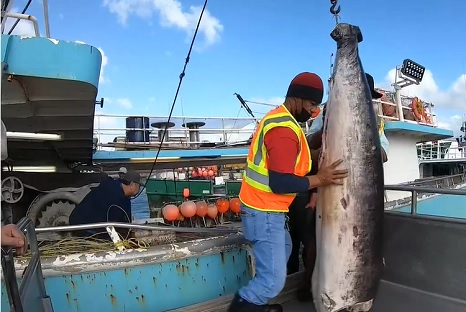
Have you tried the other white meat? … Swordfish
Hawaii’s commercial fishing industry is asking Hawaii families to consider (or reconsider) a fish that’s fallen out of favor over the years. While Hawaii is known for its ahi and other tuna, swordfish is actually a big part of the commercial fishing industry in the islands. So much so that the Hawaii Longline Association says its fleet provides about half the country’s demand for swordfish, caught more than 1,000 miles north of Hawaii. But while more than 80% of the fresh fish sold in Hawaii stays here, that’s not the case for swordfish. “It’s kind of reverse, most goes to the mainland instead of retain here locally,” said Eric Kingma, executive director of the Hawaii Longline Association. Video, >click to read< 08:49
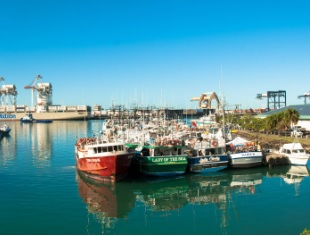
Hawaii Longline Fishery Achieves Global Sustainability Certification
The Hawaii Longline Association’s swordfish, bigeye, and yellowfin tuna fishery has achieved certification for sustainable fishing practices, the Marine Stewardship Council announced today. The fishery is the first Hawaii fishery to enter the MSC program. The MSC Fisheries Standard is a globally recognized standard used to assess if a fishery is well-managed and reflects the most up-to-date understanding of internationally accepted fisheries science and management. The certification follows a rigorous 16-month review carried out by third-party assessment body Control Union UK Limited. >click to read< 16:09
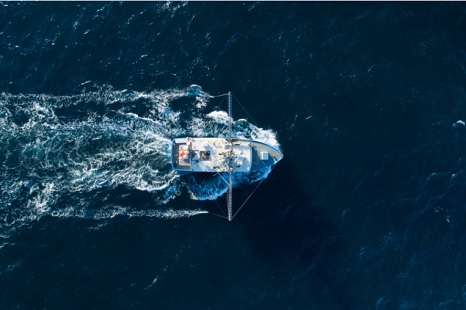
How this family-run seafood business banded together to stay afloat for the next generation
When the Bright kids were young, Bill was away at sea often, “probably 150 days a year,” he says. One Sunday he came home from a fishing trip in New England, gathered the family around the table, and floated an idea for a new adventure, a restaurant. Well, not a restaurant-restaurant, but a kitchen trailer parked by the docks on Richardson Channel, with picnic tables where customers could see the freshness of the fish, guts and scales and all, being butchered a few feet away. “The kids were into it right away.” Bill and Michelle, a Temple-trained journalist and ace home cook, opened Hooked Up Seafood in 2010 and quickly developed a reputation of excellence. photos, >click to read< 07:48
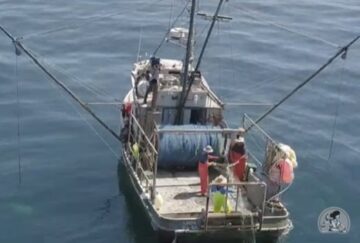
Blue collar fishermen deserve to make a living, not persecution from weak minded politicians and wealthy enviros
Austen Brown started fishing commercially with his father off California’s coast when he was only 8 years old. By the time he was 13, Austen was making his own living as a fisherman, and he has spent the past few decades fishing for everything from codfish to shark. But perhaps his favorite target is the elusive swordfish.,, The swordfish is also a favorite catch for Chris Williams, who has spent more than 40 years plying his commercial fishing trade off the California coast, including targeting swordfish with drift gillnets. Tragically, California’s drift gillnet ban comes at the expense of the fishermen and their families who will be put out of business for no good reason. Video, >click to read< 08:34

Pacific Legal Foundation: Lawsuits filed to preserve swordfish industry and livelihoods
Swordfish is one of the most popular types of seafood. It is also a primary source of income for Chris and Dania Williams and a way of life for their entire family. Chris has been a swordfisherman for decades, and husband and wife have been selling their fresh catch at their Ventura market for nearly a decade. Chris is among approximately 20 active swordfish permit-holders in the state, many of whom also have run small, family-owned businesses,, California recently passed a law to phase out the remaining permits for swordfish, or drift gillnets, which are the only viable method for commercial swordfishing. This would end swordfishing in the state, even though federal regulations clearly allow the practice. more >click to read< 14:12
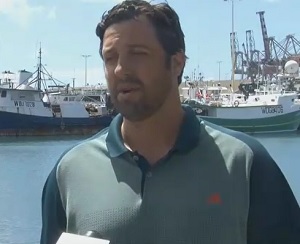
Swordfish season could re-open later this year
A sudden end to the “Swordfish Season” for Hawaii long-liners, but not because the fish stock is running low. Instead, it is because of run-ins with another ocean creature. “This year the swordfish industry is closed, it closed about two weeks ago,” stated Eric Kingma the Executive Director for the Hawaii long line Association. But those boat had to suddenly shutdown because of 17 loggerhead turtles, which are an endangered species. Video, >click to read<11:13
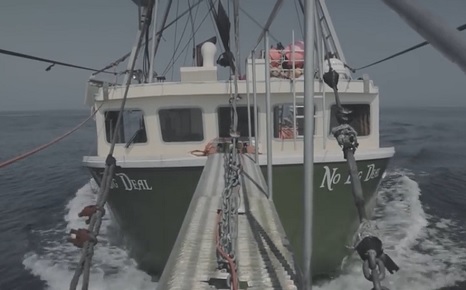
Mightier Than the Swordfish: Nova Scotia’s Harpoon Fishermen
A hundred miles off the coast of Nova Scotia, fishermen are in offseason mode. If it were wintertime, they’d be hauling lobster in closer to shore. But now, in July, they’re far from the familiar topography of Shag Harbor. They’re on the lookout for swordfish, and they’re using a deadly tool rarely seen in Western waters anymore: harpoons.,, He’s looking for one thing: a fin as it “nicks” the surface. The swordfish’s crescent-shaped dorsal fin is distinct from that of a sunfish or dolphin, but more easily confused with a shark’s. If the fin seems worth pursuing, the captain steps on the gas, and the harpooner prepares to “stick” the fish. Video, >click to read<09:04

20K-Pound Fresh Fish Catch Helps San Diego Maritime Industry
Thousands of pounds of fish were offloaded Thursday in Point Loma, an occurrence that happens a few times a month in San Diego but is part of an evolving maritime industry. The Port of San Diego is highlighting the commercial fishing industry for “Maritime Month.” Many of the fishermen who work in San Diego have been a part of the local fishing industry for generations and spend weeks at a time at sea. On Thursday, four of those fishermen aboard the boat “Anthony G” used forklifts to unload about 20-thousand pounds of swordfish, tuna, manchong and other fresh catches at Driscoll’s Wharf in Point Loma. Video, >click to read<16:47
Greased Lightning! Self-Lubricating Swordfish Secrete Oil to Swim Faster
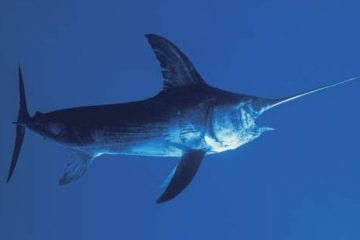 Swordfish may look like formidable beasts, what with their namesake prong jutting out from their noses. That pointy-looking nose, however, isn’t as strong as it may look, thanks to a thin section of bone at its base that shares the space with a particularly large gland. Now, after years of puzzling over its purpose, scientists believe they finally have the answer: the gland helps swordfish swim faster by coating their heads in oil. In a recent study published this week in the Journal of Experimental Biology, scientists from University of Groningen in the Netherlands say that the mysterious gland is linked to pores on the fish’s head through a system of capillaries. These pores then secrete an oily film that could potentially reduce the drag that swordfish experience when swimming—with top speeds reaching over 62 miles per hour. Read the rest here 17:47
Swordfish may look like formidable beasts, what with their namesake prong jutting out from their noses. That pointy-looking nose, however, isn’t as strong as it may look, thanks to a thin section of bone at its base that shares the space with a particularly large gland. Now, after years of puzzling over its purpose, scientists believe they finally have the answer: the gland helps swordfish swim faster by coating their heads in oil. In a recent study published this week in the Journal of Experimental Biology, scientists from University of Groningen in the Netherlands say that the mysterious gland is linked to pores on the fish’s head through a system of capillaries. These pores then secrete an oily film that could potentially reduce the drag that swordfish experience when swimming—with top speeds reaching over 62 miles per hour. Read the rest here 17:47Pew Enviro Fueled Legislative Witch Hunt: An end to ‘curtains of death’?
 California Assembly and Senate have asked federal fishery managers to end drift gillnets, which some call “curtains of death.” California remains the only state where drift gillnet fishing are legal. The legislature has authority over remaining gillnet permits. Recently lawmakers sent a letter to Pacific Fishery Management Council and National Marine Fisheries Service, demanding a transition to alternative fishing methods. Read the rest here 08:08
California Assembly and Senate have asked federal fishery managers to end drift gillnets, which some call “curtains of death.” California remains the only state where drift gillnet fishing are legal. The legislature has authority over remaining gillnet permits. Recently lawmakers sent a letter to Pacific Fishery Management Council and National Marine Fisheries Service, demanding a transition to alternative fishing methods. Read the rest here 08:08
Swordfish Facts – The Fishery, and the Fish
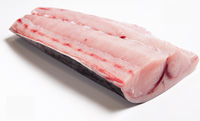 Swordfish are pursued worldwide by the fleets of more than 20 nations. In the U.S., swordfish are landed from Maine to Louisiana, as they migrate up and down the East Coast. U.S. swordfish catches peaked in 1993 at just over 10,000 metric tons. In recent years, following the introduction of a variety of conservation measures, U.S. catches have fluctuated between 3,500 and 4,000 metric tons. Read more here 16:19
Swordfish are pursued worldwide by the fleets of more than 20 nations. In the U.S., swordfish are landed from Maine to Louisiana, as they migrate up and down the East Coast. U.S. swordfish catches peaked in 1993 at just over 10,000 metric tons. In recent years, following the introduction of a variety of conservation measures, U.S. catches have fluctuated between 3,500 and 4,000 metric tons. Read more here 16:19
Deepwater Horizon oil left tuna, other species with heart defects likely to prove fatal
 The BP Deepwater Horizon oil spill struck at the very heart of fish, a new study says. Exposed to millions of gallons of crude, young tuna and amberjack, some of the speediest predators in the ocean, developed heart defects that are likely to limit their ability to catch food. Read more here wapo 09:02
The BP Deepwater Horizon oil spill struck at the very heart of fish, a new study says. Exposed to millions of gallons of crude, young tuna and amberjack, some of the speediest predators in the ocean, developed heart defects that are likely to limit their ability to catch food. Read more here wapo 09:02
Commericial restrictions lifted to match new federal rules – Swordfish now can be caught in North Florida waters
Conforming to less-restrictive federal rules that went into effect in August, the Florida Fish and Wildlife Conservation Commission decided Thursday that commercial fishermen can catch and sell three swordfish per vessel, per trip, within the three-mile distance from shore that Florida governs. Read more@jacksonville.com 23:09
TUNA SHOWDOWN: Pacific tuna stock faces growing crisis of inaction
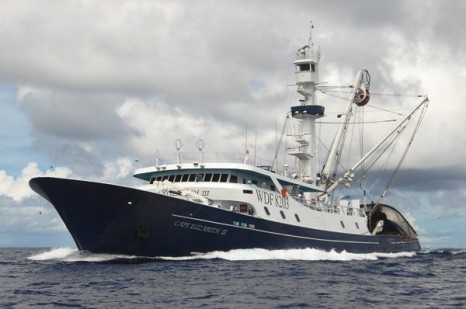 A showdown that could decide the sustainability of the US$7 billion Pacific tuna industry is expected at the annual meeting of the Western and Central Pacific Fisheries Commission (WCPFC) in Cairns, Australia, on December 2-6. more@islandbusiness.com 12:33
A showdown that could decide the sustainability of the US$7 billion Pacific tuna industry is expected at the annual meeting of the Western and Central Pacific Fisheries Commission (WCPFC) in Cairns, Australia, on December 2-6. more@islandbusiness.com 12:33
Atlantic Highly Migratory Species: Swordfish Landings Update Through September 30, 2013 Sharks through October 18, 2013.

 Please see the attached swordfish landings update as of September 30, 2013. For previous swordfish landings updates, click here Shark Landings Update Through October 18, 2013 click here 16:53
Please see the attached swordfish landings update as of September 30, 2013. For previous swordfish landings updates, click here Shark Landings Update Through October 18, 2013 click here 16:53
Swordfish Find Squid Delicious; Suffer Consequences
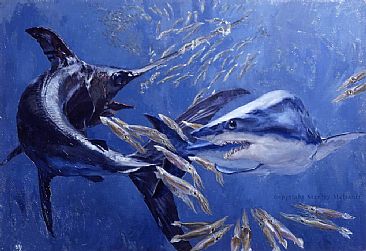 science2.0 – From a certain perspective, it’s really weird that we manage fisheries in these discrete little units based on species. There are swordfish permits, swordfish boats, swordfish managers. There are squid permits, squid boats, squid managers. And so on. But species don’t exist in neat boxes. That’s the fundamental truth behind ecology. When you go out to catch one species, you’re bound to run across several other species as well, and even the most carefully designed fishing gear will occasionally catch something it wasn’t supposed to. continued
science2.0 – From a certain perspective, it’s really weird that we manage fisheries in these discrete little units based on species. There are swordfish permits, swordfish boats, swordfish managers. There are squid permits, squid boats, squid managers. And so on. But species don’t exist in neat boxes. That’s the fundamental truth behind ecology. When you go out to catch one species, you’re bound to run across several other species as well, and even the most carefully designed fishing gear will occasionally catch something it wasn’t supposed to. continued
Return to Swordfishing? Lost Fishing Tradition May Be Restored – public hearing in Gloucester on Thursday, March 28.
 With the healthy restoration of swordfish along the eastern seaboard, the National Oceanic and Atmospheric Administration fisheries service said it is now considering an open-access permit that could return swordfishing to Island waters by opening access to all fishermen, and small-boat fishermen in particular. The National Marine Fisheries Service will host a public hearing in Gloucester seeking comment on the proposed permit on Thursday, March 28. continue
With the healthy restoration of swordfish along the eastern seaboard, the National Oceanic and Atmospheric Administration fisheries service said it is now considering an open-access permit that could return swordfishing to Island waters by opening access to all fishermen, and small-boat fishermen in particular. The National Marine Fisheries Service will host a public hearing in Gloucester seeking comment on the proposed permit on Thursday, March 28. continue







